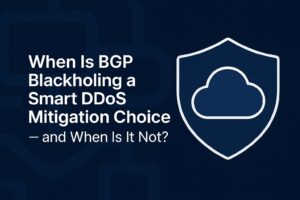When Is BGP Blackholing a Smart DDoS Mitigation Choice, and When Is It Not?

BGP Blackholing, also known as RTBH (Remotely Triggered Black Hole), is a long-standing and widely used method for mitigating DDoS attacks. By leveraging upstream network infrastructure, it can drop malicious traffic before it ever reaches your systems.
Despite its speed and effectiveness, RTBH is not a universal solution. In some cases, it can do more harm than good. Understanding when to apply blackholing—and when to avoid it—is crucial for maintaining availability and minimizing risk during an attack.
What Is BGP Blackholing?
RTBH is a routing technique that advertises a specific IP or prefix with a special BGP community tag. This tag signals upstream routers to drop all traffic to that destination by redirecting it to a null route (Null0). From the attacker’s perspective, the target effectively vanishes from the internet.
This method is especially useful in high-volume attacks, where simply absorbing or filtering the traffic is not viable.
When BGP Blackholing Is Effective
- Volumetric Layer 3/4 Attacks – blackholing is particularly effective during large-scale UDP floods, SYN floods, or other infrastructure-level attacks. It can immediately relieve bandwidth and processing pressure.
- Attacks on Non-Critical Services – if the attacked host is already down or serves a non-essential function, blackholing it prevents the attack from impacting more important parts of your network.
- Protecting Shared Infrastructure – in scenarios where a DDoS attack threatens critical shared assets—like core routers, uplinks, or firewalls—blackholing a single destination IP can help protect the wider network.
- Emergency Response – when time is limited and an attack is overwhelming, RTBH serves as a fast triage measure, buying time to implement more precise or granular mitigation techniques.
- As Part of a Layered Defense Strategy – RTBH can be one component in a broader, multi-layered DDoS protection strategy, working alongside solutions like FlowSpec, scrubbing, application-layer firewalls, and anomaly detection.
When BGP Blackholing Is Risky or Ineffective
- Critical Services or Customers – RTBH drops all traffic, malicious and legitimate. If the targeted IP supports a key business service, blackholing it amounts to taking that service offline entirely.
- Application-Layer Attacks – Layer 7 attacks, such as HTTP floods or bot-based attacks, often mimic normal user behavior. RTBH cannot detect or filter this kind of traffic, making it ineffective against such threats.
- Distributed or Spoofed Attacks – if an attacker is targeting multiple IPs or spoofing sources, blackholing a single destination won’t stop the attack. In some cases, it may simply cause the attacker to shift targets.
- Shared IP Environments – in multi-tenant scenarios, such as shared hosting or virtualized environments, blackholing a single IP may inadvertently disrupt multiple services or customers.
- Overuse or Misconfiguration – improper or aggressive use of RTBH can cause accidental outages. Clear logic and well-defined thresholds are essential to avoid self-inflicted damage.
A Better Approach: Intelligent DDoS Mitigation from CoreTech
At CoreTech, we believe companies shouldn’t have to choose between total service blackouts and network protection. That’s why we offer both cloud-based mitigation and on-premise appliances that allow for granular, intelligent filtering, without dropping all traffic.
- Cloud-Based Mitigation – CoreTech’s globally distributed DDoS mitigation platform uses Anycast routing and eBPF/XDP-based packet filtering to stop attacks at the edge. This means attack traffic is scrubbed before it ever gets near your infrastructure, keeping services online and performance stable.
- CoreEdge for On-Premise Protection – for organizations that require full local control, our CoreEdge appliance provides hardware-accelerated, inline DDoS mitigation. It integrates directly into your network and uses real-time flow analytics and application-layer filtering to neutralize threats without disrupting legitimate traffic.
Proactive, Not Reactive
Unlike traditional approaches that rely on volumetric thresholds or manual blackholing, CoreTech uses advanced detection and filtering mechanisms that adapt to the nature of the attack, whether volumetric, application-layer, or multi-vector.
By combining visibility, precision, and scalability, CoreTech helps businesses defend their networks without making painful trade-offs.
BGP Blackholing has its place in the DDoS mitigation landscape. It’s a quick and sometimes necessary tactic, especially in severe volumetric attacks. But it’s also a blunt instrument that, if misused, can disrupt critical services and damage customer trust.
With the increasing complexity of DDoS threats, the future lies in smarter, more adaptive solutions. CoreTech’s approach eliminates the need for last-resort tactics by providing real-time, high-performance mitigation in the cloud, at the edge, or on-premises.
Want to learn how CoreTech can protect your business without blackholing your services?
Contact us to schedule a consultation: [email protected]
FAQs
- What is BGP blackholing used for? A: It’s used to drop all traffic to a specific IP under attack, reducing load on the infrastructure.
- Is RTBH safe for critical services? A: No. It disconnects the service entirely, so it’s unsuitable for mission-critical systems.
- How does CoreEdge differ from blackholing? A: CoreEdge filters malicious traffic while allowing legitimate traffic through, avoiding service disruption.
- Can CoreTech handle Layer 7 attacks? A: Yes. Our AI-driven filtering detects and mitigates both volumetric and application-layer threats.
- Is CoreTech’s solution suitable for all business sizes? A: Absolutely. Our solutions are scalable and customizable for ISPs, enterprises, and small businesses alike.

